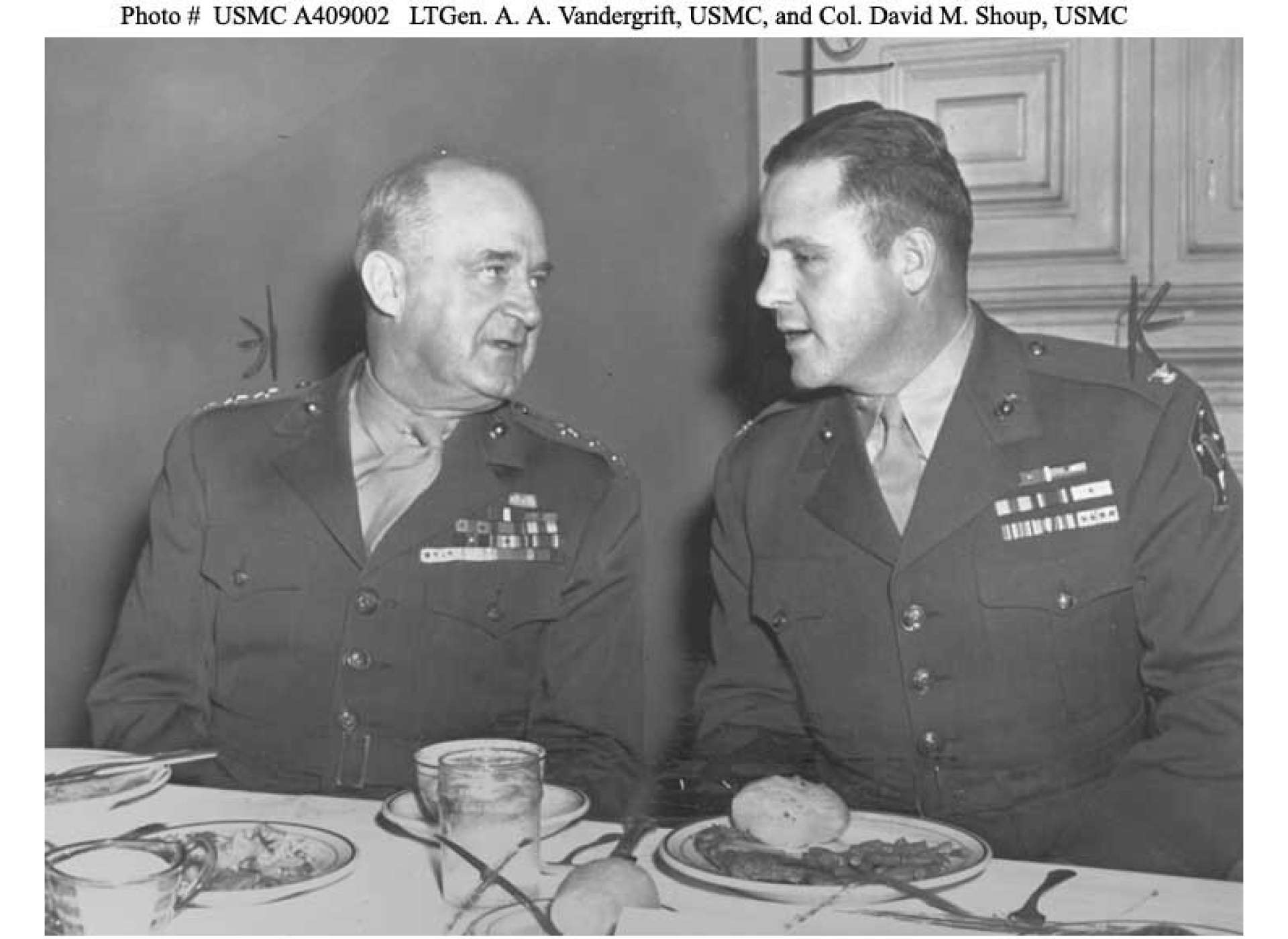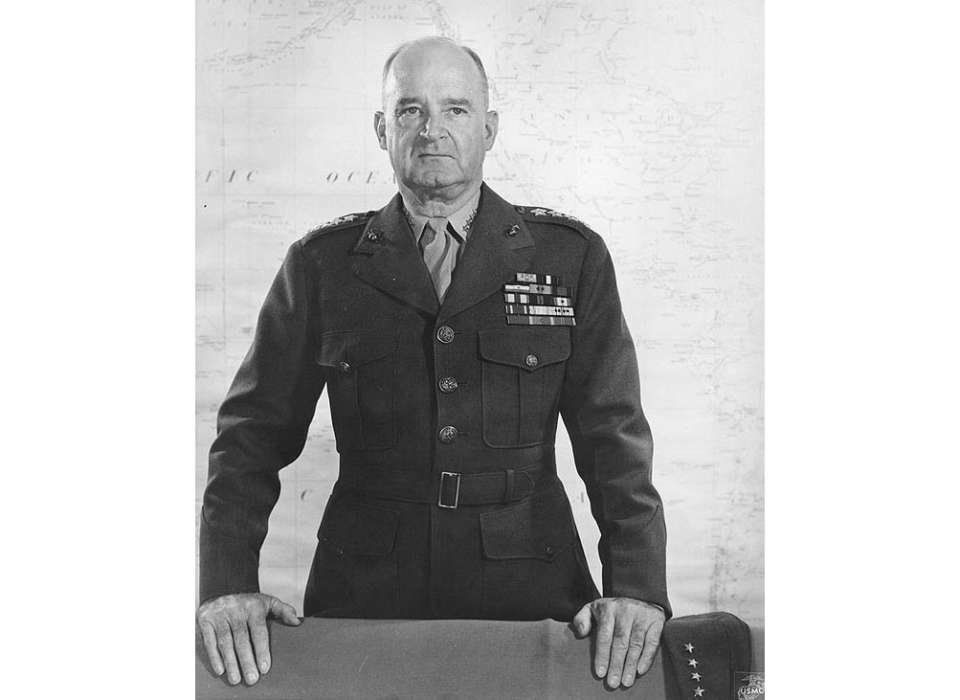Top image: General Alexander A. Vandegrift, Commandant of the United States Marine Corps, circa 1945. Credit: Official U.S. Marine Corps photo, from the Collections of the Naval Historical Center.
General. Commandant. Medal of Honor winner. These are just three of the titles Alexander A. Vandegrift (1887-1973) held during his long and lauded career in the United States Marine Corps.
Most people recognize Vandegrift’s name from the Guadalcanal Campaign, when he commanded the 1st Marine Division during the vicious fighting with the Japanese on that island in the Solomons from August until December 1942. The citation accompanying the Medal of Honor he received for his leadership on Guadalcanal, praising his “tenacity, courage, and resourcefulness” “against a strong, determined, and experienced enemy,” expressed the gratitude of a nation. Others know of his tenure leading the 1st Marine Amphibious Corps at Bougainville in 1943 or his time as 18th Commandant of the US Marine Corps (1944-46).
Vandegrift’s accomplishments during World War II, however, came near the end of almost four decades of service in the Marines. Born in 1887 in Charlottesville, Virginia, he attended the University of Virginia, the institution founded by Thomas Jefferson, before being commissioned into the Marines as a 2nd Lieutenant in January 1909. That year, he wrote a paper, “Aviation, the Cavalry of the Future,” defending the use of air power. Although ahead of its time, the text did not impress his superiors. For the next fifteen years, he was assigned to duty in Cuba, Nicaragua, Mexico, and Haiti, involved in missions that generated controversy and opposition, then and in our own time.
Two different postings to China, considerable officer training, and administrative experience in several different locations in the United States followed. General John Lejeune, a legendary figure in the history of the Marine Corps, mentored him. Lejeune, who would also serve as commandant of the Marine Corps, passed on to Vandegrift his immense knowledge of planning, strategy, and tactics, particularly his understanding of amphibious warfare. Continuing to excel, Vandegrift was promoted to Lieutenant Colonel in June 1934. By that point, President Franklin D. Roosevelt’s Good Neighbor Policy had ended the utilization of the Marine Corps for enforcing the hated interventions in the affairs of Latin American countries, and the Roosevelt Administration had withdrawn US troops from Nicaragua and Haiti.
In May 1937, Vandegrift was made Military Secretary to Marine Corps Commandant Thomas Holcomb. Working closely with Holcomb, he was introduced to the latest thinking on military strategy and to the growing emphasis in the US military on cooperation between the service branches. During those years, Vandegrift watched as the international situation swiftly deteriorated with Imperial Japan’s invasion of China in July 1937 and Nazi Germany’s expansionist moves in Central and Eastern Europe in 1938-39.
Six months after Adolf Hitler’s invasion of Poland, Holcomb promoted Vandegrift to Assistant to the Commandant and then, in April 1940, Brigadier General. When President Roosevelt decided to strengthen America’s military after the fall of France in 1940, Vandegrift was one of the key figures involved in ensuring the Marine Corps’s readiness. The US Marine Corps would nearly double in size, from just 28,345 men in 1940 to 54,359 by the end of 1941.
In November 1941, the month before Pearl Harbor, Vandegrift was assigned to the 1st Marine Division, Fleet Marine Force. An expansion of the 1st Marine Regiment founded in 1913, the 1st Marine Division had been established on February 1, 1941 on the battleship USS Texas. As the largest, oldest, and most decorated division in the Corps, it would eventually earn nine Presidential Unit Citations.
News of the Japanese attack on Pearl Harbor on December 7, 1941 and the deaths of 2,400 Americans, 109 of them Marines, left Americans horrified and enraged. With the Congressional Declaration of War the following day, Vandegrift and the United States Marine Corps knew they would comprise a vital part of any American response.
Marines considered themselves an elite and aggressive fighting force and that perspective was borne out by their comrades’ heroic stand on Wake Island (December 8-23, 1941), where a garrison of 449 US Marines along with a handful of Navy, Army, and civilian personnel inflicted grievous losses on the Japanese invasion force. The Japanese lost four warships, twenty-one aircraft, a submarine, and 1,000 men before overwhelming the island’s defenders. With the rallying cries “Remember Pearl Harbor” and “Remember Wake Island,” the US Marines prepared to battle an enemy they considered treacherous and merciless. The expansion of the Marine Corps, already underway, had to accelerate.
Vandegrift and the 1st Marine Division received a steady stream of disheartening reports from the Pacific during the first four months of 1942. Word came on January 23 of Japan’s capture of the city of Rabaul on the northeastern tip of New Britain Island. The British colony of Singapore fell to the Japanese on February 15. On March 8, Japanese forces moved into New Guinea. Conditions in the Philippines turned against the US, and, on May 6, US Army Lieutenant General Jonathan Wainwright surrendered all American forces on the islands. But there were signs of hope and defiance, too. The Doolittle Raid on Tokyo on April 18, and the success of the United States Navy against the Japanese fleet during the Battle of the Coral Sea (May 4-8) raised morale. The Japanese were not invincible.
In the spring of 1942, orders arrived. As the first Marine division to leave US shores, the 1st Marine Division would deploy to the South Pacific. There they would help stem the Japanese advance toward Australia. Showing his strong confidence in Vandegrift, Commandant Holcomb promoted him to Major General.
On May 20, 1942, USS Wakefield, a troop transport, departed Norfolk, Virginia, bearing the advance echelon of Major General Vandegrift’s 1st Marine Division. The troop transport carried more than 4,700 Marines, as well as some 300 Navy and Army personnel. It sailed as part of a convoy, since German submarine attacks had already devastated American shipping in the previous several months. In Panama, Wakefield separated from the convoy, relying on its speed and maneuverability to escape threats.
After almost four weeks at sea, Wakefield docked in Wellington, New Zealand, on June 14, 1942. Vandegrift and his Marines were part of the first wave of some 100,000 Americans who were stationed in that island country in 1942-43.
The transition to life in the South Pacific came with immediate challenges. A strike by dockworkers in Wellington, already underway, did not abate with the arrival of Vandegrift’s unit. All the cargo that had traveled thousands of miles from Norfolk had to be unloaded by the Marines themselves. Heavy rains ruined much of the food, especially cereals and sugar, before it could be unloaded. There was also the overarching question: now that the Marines were there, what would they do?
Three weeks after the United States victory at Midway, Admiral Ernest J. King, Commander in Chief of the US Fleet and Chief of Naval Operations, told Admiral Chester Nimitz, Commander in Chief, Pacific Ocean Areas, to get ready for an offensive in the Lower Solomon Islands. Vice Admiral Robert Ghormley would handle assignments for the mission. It was time to check Imperial Japan’s advance toward Australia and safeguard communication lines to Australia and New Zealand.
The Japanese had exerted control in the Northern Solomon Islands, grabbing Bougainville, then heading south and capturing the islands of Tulagi and Guadalcanal. In early July 1942 American military intelligence detected Japanese forces building a landing field on Guadalcanal. American planners realized this airstrip had the potential to disrupt supply lines to Australia. Hastily, they assembled an invasion force consisting of the 1st Marine Division to take the island, neighboring Tulagi, formerly the seat of the British Resident Commissioner, with its excellent harbor, and Florida, also north of Guadalcanal. Codenamed Operation WATCHTOWER it would be the first amphibious and offensive operation undertaken by the US military during World War II.
For Major General Vandegrift and his men, the announcement of Operation WATCHTOWER was a shock. Vandegrift had been led to believe he would have much more time to train his Marines in New Zealand for what lay ahead. At the earliest he expected his unit to see combat in early 1943. The division was not even at full strength in late June and the timetable for WATCHTOWER had been established for the beginning of August. Would there be enough time to really make this offensive work?
As the first volume of the Marine Corps’s History of the U.S. Marine Corps Operations in World War II characterized it, “problems facing Ghormley and Nimitz were so grim that the pseudo code name for the undertaking soon became ‘Operation Shoestring.’” Conflicts over the command structure had to be ironed out—Vandegrift wanted the landing commander to direct the operation once ashore and not share responsibility with Rear Admiral Richmond K. Turner, Commander of Amphibious Force, South Pacific. Once Vandegrift’s view reached the top of the chain in the Navy, it won out.
Relentless preparation for a landing consumed Vandegrift’s time for a month. The second echelon of the 1st Marine Division only arrived on July 11. So speed and sweated labor (the unionized stevedores were still striking) were of the essence to prepare everything for the voyage and subsequent assault. On July 18, it was time to depart Wellington. All of the division’s 155mm howitzers and trucks had to be left behind in New Zealand. Vandegrift staged landing drills on the island of Koro in the Fiji Islands from July 28-30. Reefs prevented the men from doing very much. Deeply unimpressed, Vandegrift described the drills as a “complete bust.” By that point, he also learned that air and surface support for the implementation of the unloading phase of Operation WATCHTOWER would not match his expectations. On July 31, 19,000 Marines from the 1st Marine Division embarked from Koro in 19 transports and four destroyer-transports. D-Day on Guadalcanal would be Friday, August 7, 1942.

Lieutenant General Vandegrift with US Marine Corps Colonel (and fellow Medal of Honor recipient) David Shoup, 1943. Credit: Official U.S. Marine Corps photo, #A409002.
What Major General Vandegrift and the 1st Marine Division did on Guadalcanal in the four months after their August 7 landing has been extensively documented. Vandegrift acquired the reputation as a commanding officer who cared about his troops yet also exhibited unflinching resolve. He would not only receive the Medal of Honor from President Roosevelt at the White House on February 5, 1943, three days before Guadalcanal was deemed “secure,” but also the Navy Cross (the first Marine to win both). For its sacrifice and valor in the Guadalcanal Campaign, the 1st Marine Division would be awarded its first Presidential Unit Citation.
Beyond those honors, Lieutenant General Vandegrift and his unit contributed crucially to a decisive American victory in the Pacific Theater. Confidence in the US and Allied war effort against the Axis Powers waxed substantially in 1943, and, in retrospect, it is not a surprise that Vandegrift (he was appointed General in April 1945, the first officer in the history of the Marine Corps to attain the four-star rank) was picked late that year as the next commandant of his beloved Marine Corps.
Jason Dawsey, PhD
Jason Dawsey, PhD, is ASU WWII Studies Consultant in the Jenny Craig Institute for the Study of War and Democracy.
Cite this article:
MLA Citation:
APA Citation:
Chicago Style Citation:







![Max Fuchs, New York City cantor, sings as Rabbi Sydney [sic] Lefkowitz, Richmond, VA, conducts the first Jewish services from Germany.](/sites/default/files/styles/max_650x650/public/2025-10/image1.jpg)

